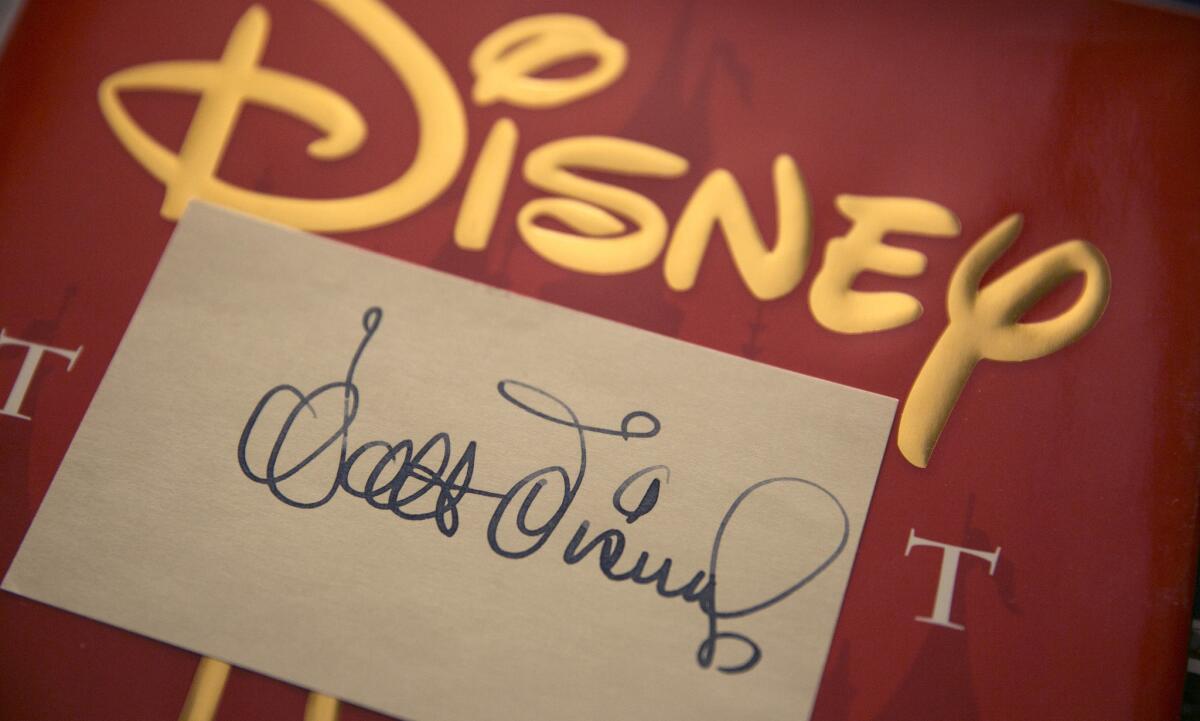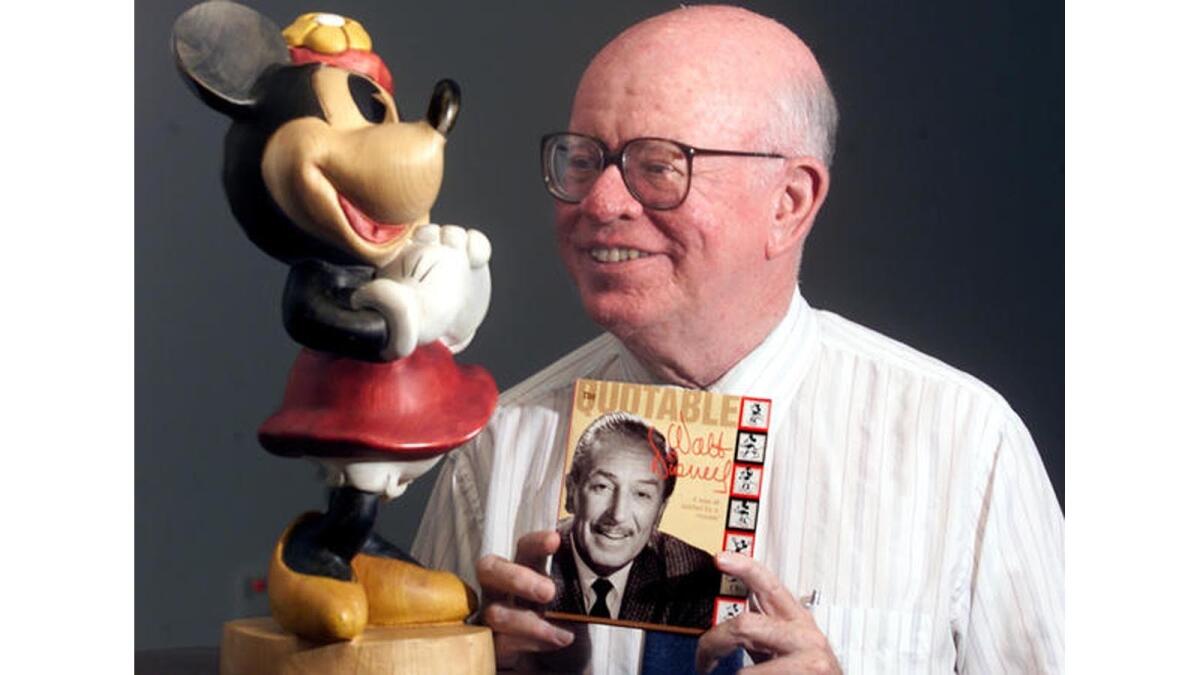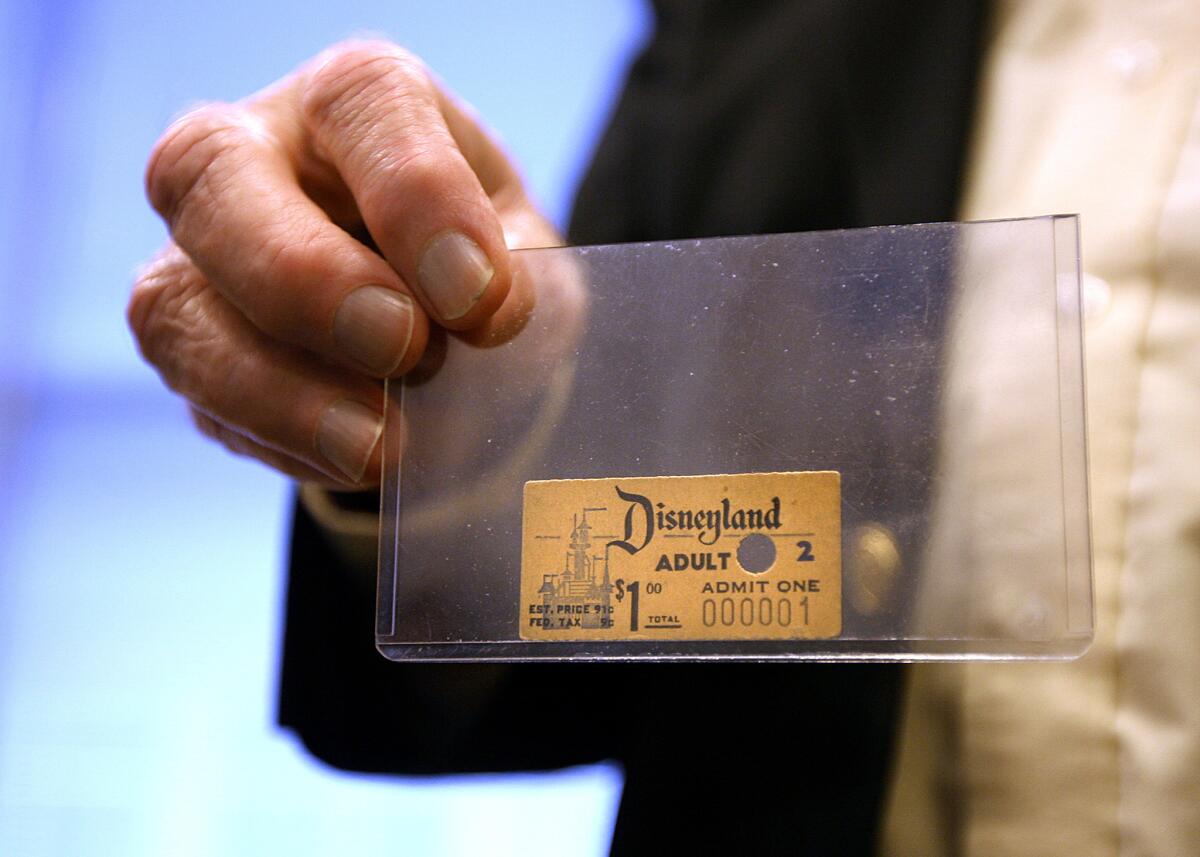The keeper of Disney’s legacy, archivist Dave Smith spent 40 years preserving the history of an American icon

Dave Smith created the Walt Disney Archives in 1970.
- Share via
Dave Smith couldn’t believe his luck. He was visiting Disneyland with his family about a year after its opening and spied Walt Disney strolling down the park’s Main Street.
In his later years as a serious autograph collector, Smith would go on to acquire the signature of every person who signed the Declaration of Independence except for one (Button Gwinnett). But back on that day in 1956, the only autograph that mattered to the then-15-year-old Smith was Disney’s.
However, when Smith approached Disney in the courtyard of Sleeping Beauty Castle, the executive refused to put pen to paper.
“He said when he started signing his autograph he got all these crowds around him and he never could get his work done,” said Smith, 76, adding that Disney told him to write him a letter requesting an autograph and he’d be glad to mail him one. (Disney followed through.)
It was a pleasant enough exchange, but looking back on it, Smith wishes that Disney could’ve somehow known what was to become of him. Because four years after the mogul died, Smith was hired by Walt Disney Co. in 1970 to be its first archivist. He’d go on to create the Walt Disney Archives — a vast repository for its intellectual property — and run it for 40 years.
“I’ve always wondered, what if he would have realized then what I would be doing 15 years later?” said Smith, who retired in 2010 but remains a consultant for Disney. “And what if I had realized then what I would be doing 15 years later? The questions I could have asked him. It would have saved me a lot of time!”

In an industry that’s notorious for neglecting its past — consider the long list of lost silent films — Smith stands out as an anomaly. He is perhaps the most respected, if unheralded, member of a small clique of in-house Hollywood historians, someone who has quietly dedicated his life to assiduously documenting, preserving and cataloging all facets of America’s most iconic entertainment company.
Disney, more than any other studio, relies on its past successes to seed its future plans. The company, for example, is in the midst of a strong run of remaking animated classics such as “Cinderella” and “The Jungle Book” into live-action pictures. When filmmakers set out to re-imagine those decades-old animated movies, they turned to the archives for research, said Rebecca Cline, the current director of the Walt Disney Archives.
If not for Smith starting the archives when he did, much of the historical information that Disney draws on today could have been lost, she said.
“We had lost Walt Disney in 1966 and [brother] Roy O. Disney was getting ready to retire — it was kind of at a critical point for Disney,” said Cline, who began working in the archives in 1993 as Smith’s secretary. “Somebody needed to gather this stuff. It was a really important step in the history of entertainment archiving.”
During his long career, Smith has written several books, including “Disney A to Z: The Official Encyclopedia.” The fifth edition, published by Disney, was released last week. First published in 1996, the book has expanded over the years and now contains 7,600 entries. It has endured as a useful tool for historians, academics and reporters — including this one — in their research of the company.
Being an official encyclopedia, the book smooths out some of the rough edges of Disney’s history. For example, entries for former top executives Jeffrey Katzenberg and Michael Ovitz make no mention of their infamously acrimonious departures from the company in the 1990s. (Yes, there’s also an entry for Smith.)

Between Smith’s role at the archives and his penning of “Disney A to Z,” many Disney fans consider him the foremost expert on the company in the world.
“People tell me I am,” said Smith, smiling. “Then again, I don’t know all these facts in my brain. I look them up in my own book. I look them up in the files of the archives.”
Smith spent decades stocking the archives with a trove of valuable items. The collection includes such varied artifacts as Walt Disney’s parents’ marriage certificate from 1888; the original script for “Steamboat Willie,” Mickey Mouse’s debut; ticket No.1 to Disneyland; and a 20-foot model of the Black Pearl ship from the first “Pirates of the Caribbean” movie. All of it has been preserved alongside more mundane material such as training manuals for theme park workers and DVDs of recent films.
When Smith started, it was a one-man job. Now 24 people work at the archives, which can be seen on tours offered by Disney’s official fan club and are open to researchers with the company’s approval.
At the time that Disney was establishing its archives, other major U.S. companies — such as Firestone Tire and Rubber Co., Johnson & Johnson and Levi Strauss & Co. — had similar operations. But Disney was the first entertainment company to create one, film historian Marc Wanamaker said.
‘Disney really set up the first studio archive to preserve and collect and maintain their history,” Wanamaker said.
Time after time, the collection, which includes millions of items — 4 million photographs alone — has proven invaluable to the company.
Former Disney Imagineer Steve Diggins said he consulted with the archives while working on the Disneyland attraction Mickey’s House, a nostalgic look at all things Mickey Mouse that is a cornerstone of the Mickey’s Toontown themed area.
“If you look at the stuff in the house, a lot of it is references to Mickey’s cartoon history and there was a lot of research done on that,” said Diggins, who worked as an Imagineer in the early 1990s when Toontown launched. “For many of the rides that they do, obviously the archives are big.”
***
Smith’s former colleagues described him as reserved, humble and quick to deflect a discussion of his personal accomplishments.
Over a recent lunch at a barbecue restaurant in Burbank, Smith lived up to that billing, revealing a deep respect for the company that employed him for decades. A company man down to his apparel, he wore a hat with a logo of the studio’s recent “Tomorrowland” film. (He also brought to the restaurant a certificate for a free dessert on the occasion of his birthday — and promptly charmed a giggly waitress into an additional on-the-house ice cream sundae.)
Smith grew up in Pasadena and got undergraduate and graduate degrees from UC Berkeley, the latter in library science. After graduate school, he worked as a reference librarian at the UCLA Research Library — a position he held when Disney died in 1966. A year after Disney’s death, Smith got the idea to compile a bibliography on the company. So he reached out to Disney and asked if it would open its files to him.
The company gave Smith its blessing, and staffers there soon helped guide his research. By the time he completed the bibliography in 1969, Disney realized that the massive document would be useful to own, and purchased it from him for “maybe $1,000,” Smith said.
“That was of course very useful when I started the archives to have that as my first bible,” said Smith, laughing as he tucked into his plate of barbecue chicken and beans.
Soon after Smith completed the bibliography, UCLA pitched Disney on the idea that its founder’s papers should be donated to the university’s library. The company turned UCLA down, in part because the files included trade secrets, Smith said. UCLA’s head librarian then suggested to Disney that it start its own archives, and Smith was intrigued by the idea.
“I went home that evening and sat down at my typewriter and wrote a letter to the Disney representatives and suggested … ‘how about I get a leave of absence from UCLA and write up a proposal for what you could do?’” he said.
He pulled together a plan, and Disney quickly selected him to carry it out — hiring him in 1970.
Smith became a dogged pursuer of information about the company, looking far and wide. In the early days, he interviewed key executives such as Roy O. Disney, ensuring that their stories would not be lost in death.
Few details escaped Smith. When he realized, years ago, that no one knew how tall Walt Disney had been, the archivist asked his widow, Lillian. When she didn’t know, Smith tracked down Disney’s passport (he was 5-foot-10). Smith also took to visiting flea markets, such as the monthly gathering at the Rose Bowl, in pursuit of items the company might want for its archives.
“He liked seeking out things — the thrill of the find,” said Jean Marana, Smith’s sister, who would accompany him on the hunts.
His efforts even led him to needle colleagues.

“Dave was kind of a pain in the butt, because every time I did something new he would be on the phone telling me he needed copies of it — new training manuals, the first admission ticket to the park, the first line of merchandise for Tokyo Disneyland,” said Jim Cora, the former chairman of Disneyland International, who worked at Disney from 1958 until 2001. “We always furnished it.”
Because the archives are so extensive, over the years the collection has been utilized by Smith as a sort of debunking tool. Many apocryphal tales about Disney and its founder have cropped up over the years. There’s the false story about Walt Disney having been dishonorably discharged from the military during World War I. (He was never in the military, but he served in the Red Cross.) Smith took pride in having the documents on hand to disprove this and other yarns.
“That’s one thing the archive has always tried to do — have the true facts,” he said.
***
Smith has lived in the same home on a quiet street in Burbank since the 1970s, not far from Disney’s headquarters.
His living room is a shrine to his time at Disney. On one wall, there’s an original drawing of him with Donald Duck that was made by artist Peter Emslie. On a bookcase rests Smith’s bronze Disney Legends award, a hall of fame honor that the company bestows biennially. In another corner, there’s an autographed photograph of Smith with current Disney Chief Executive Robert Iger.
Smith said he has no plans to stop consulting for the company.
“I don’t think he wants to let go of them, and they probably don’t want to let go of him,” said his younger sister, Marana. “They know a good thing when they have it.”
Indeed, said Cline, the current archives director, “I keep him on speed dial.”
So the work continues. Smith still writes an “Ask Dave” column for the Disney Twenty-Three fan magazine. He recently contributed a chapter to the weighty Taschen book “The Walt Disney Film Archives.” And he’s already thinking about potential additions to the next edition of “Disney A to Z.”
The latest version of the encyclopedia is 858 pages.
It’s not just a measure of Disney’s staying power. It’s a measure of a man’s life.
Follow @DanielNMiller on Twitter for film business news.
ALSO
Disney star Zendaya pops up in 3 cities in 1 day to see fans and introduce her new clothing line
Do Disney outposts in Shanghai, Tokyo and Hong Kong hold allure for U.S. visitors?
More to Read
From the Oscars to the Emmys.
Get the Envelope newsletter for exclusive awards season coverage, behind-the-scenes stories from the Envelope podcast and columnist Glenn Whipp’s must-read analysis.
You may occasionally receive promotional content from the Los Angeles Times.











